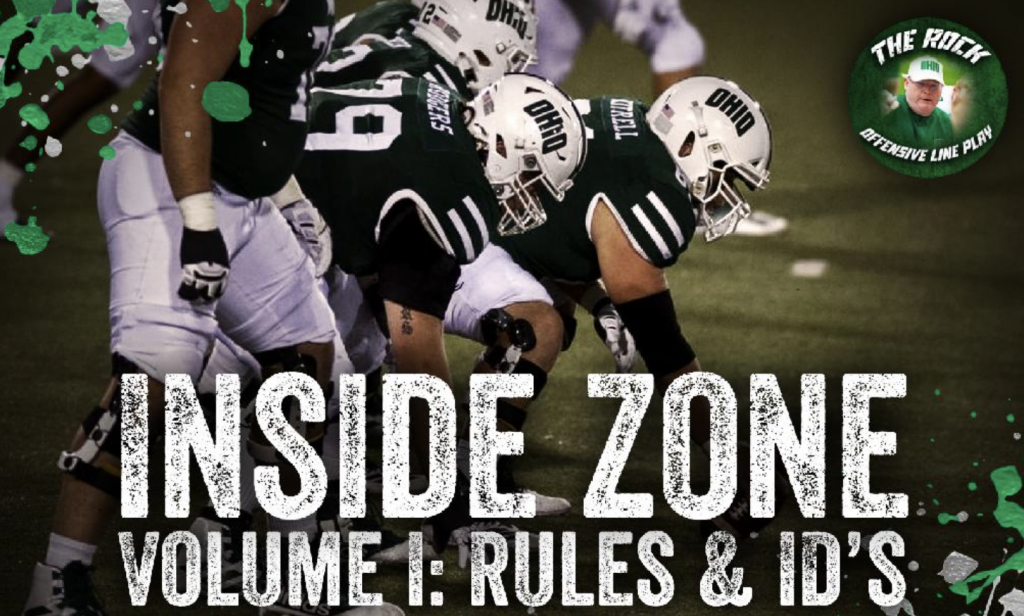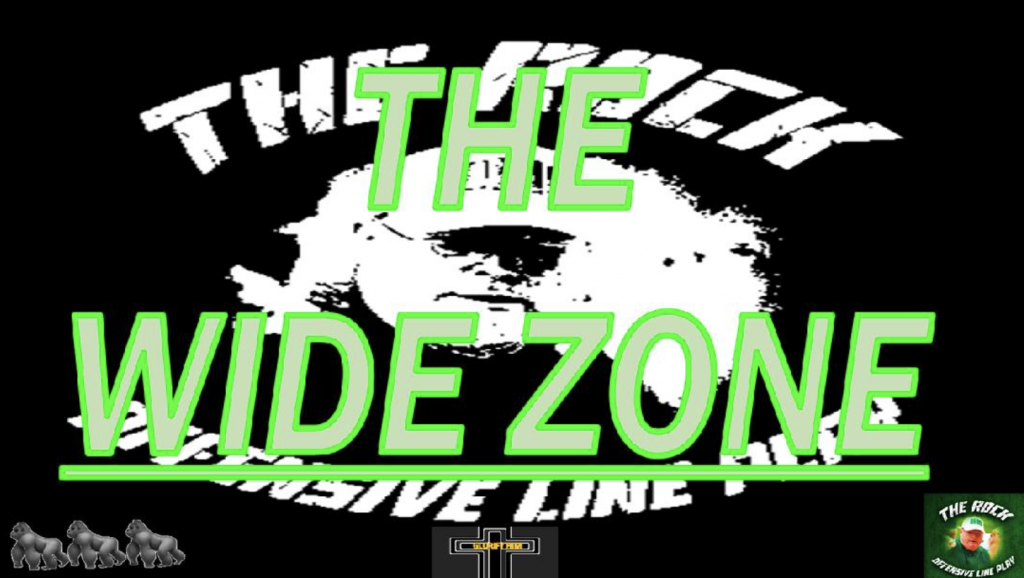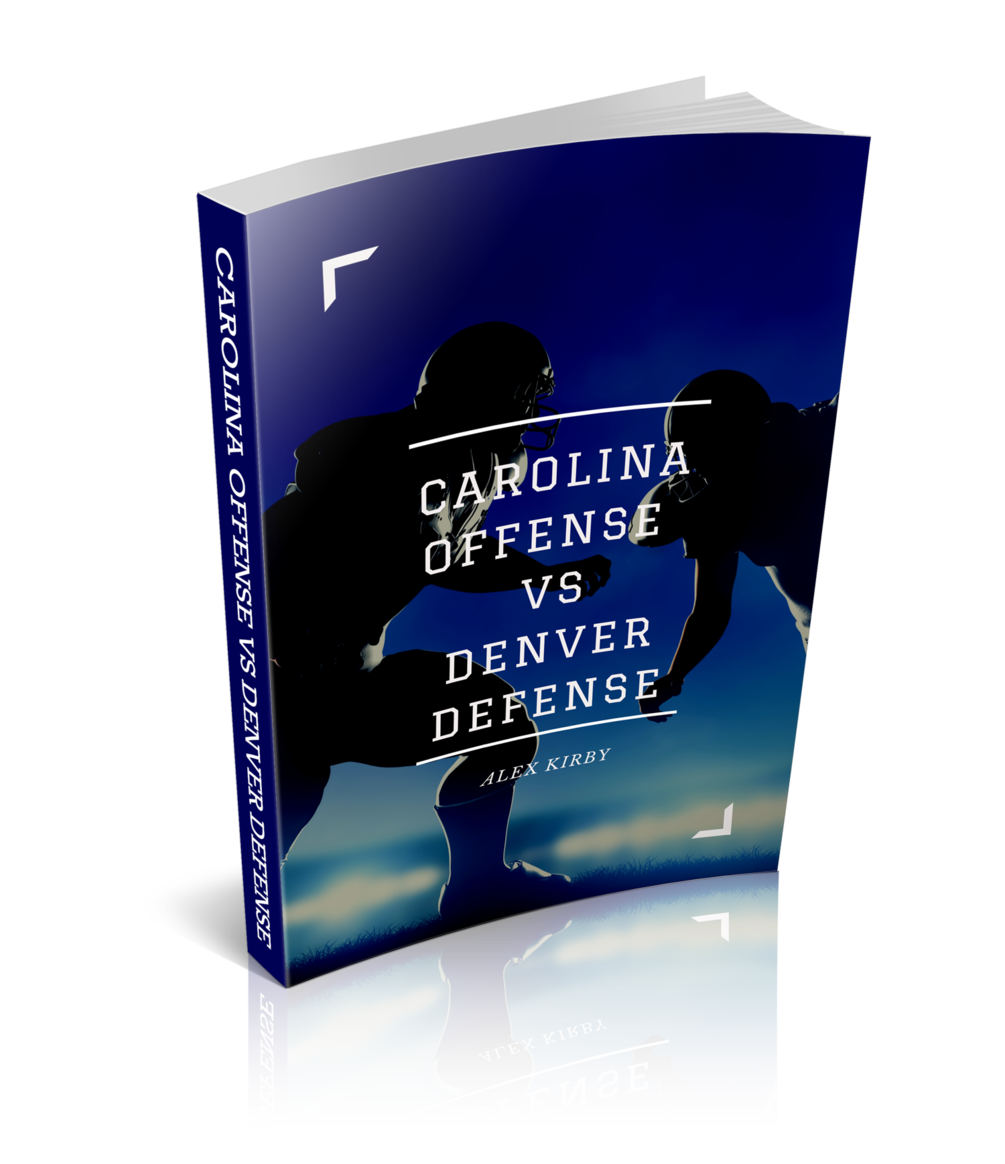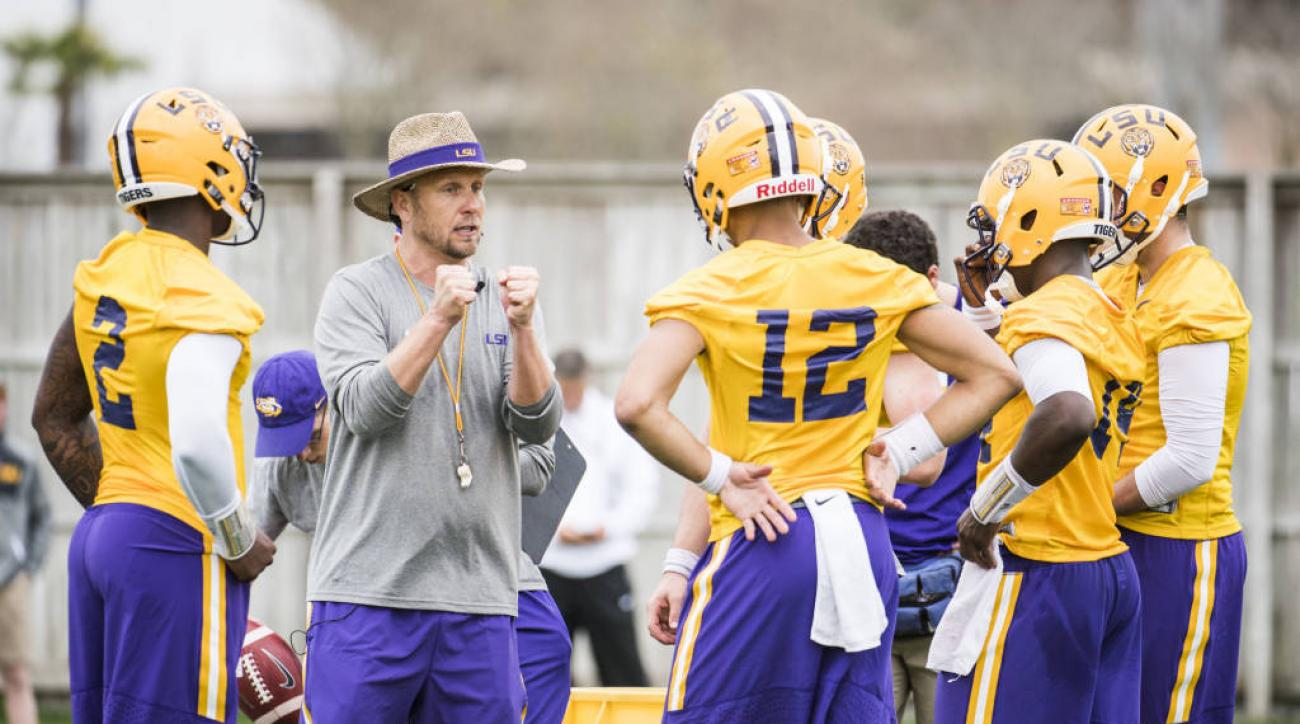When it comes to selecting the best football run play for your Offense, there are three main camps of thought in the type of blocking scheme that you can choose.
Each of these camps has its positives and negatives.
That’s why it’s critical for you to choose wisely, because if you pick a style that does not fit well, it can be a long season.
The three main categories of run plays are Zone, Gap, and Man.
After I summarize each style, I will give you some benefits and negatives to each one that should help you decide which scheme will be best for you and your team.
Zone Football Run Play
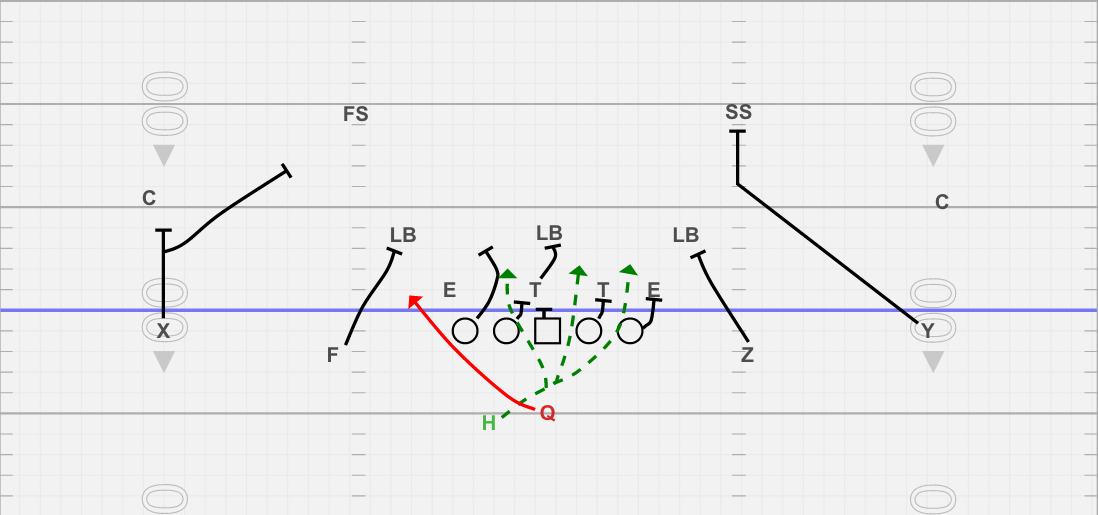
The essence of a zone blocking scheme is that each lineman is blocking an assigned zone area.
Coaches will assign rules that help each player determine who they will be blocking in their area or zone.
In a Zone run offense, there are a few plays that are run, but many, many options.
These are the inside zone, mid-zone, and outside zone.
Inside Zone
An inside zone is a run play that is designed to hit between the tackles.
It also gives your running back freedom to pick a hole.
Lineman are taught to block in a North/South manner and work for double teams on the line of scrimmage getting as much vertical movement as they can.
They need to be taught well how to stay on blocks and “cover up” their defenders so the running back can get through.
This technique can be taught to anyone, but a lineman’s size is the obvious advantage. If they are bigger, it’s easier to block and cover and double team.
With an emphasis on double teams, the lineman must learn to stay patient before going to linebacker level.
Your Running Back with first take a path to the A gap and has the option to either Bounce it outside, Bang it inside, or Bend it back.
A lot of times in the inside zone, players may have to block a defender one on one and make sure their defender doesn’t make the play.
Mid Zone or Stretch Zone
The Mid Zone football run play is set up to attack a wider aim point than the Inside Zone run.
It has had a lot of popularity with College and Pro Teams that have great running backs who can stretch and cut or bounce outside.
The Aim Point is outside the Tackle – C Gap.
Without getting too specific, the QB can hand it off or use a quick toss to get the ball to the Running Back.
The Mid Zone works by stretching defenders who have to react to the ball pressuring an outside path.
This forces defenses to move laterally to stay in their proper Gap positions because the line is stepping outside and laterally to maintain the block.
Defenses are then on the move and stretched out – which opens up running lanes for the back to attack.
The Mid-Zone is effective and can be deadly but does take considerable attention to detail and a coach that really knows the techniques to make it work.
It has won Superbowls and National Championships and many coaches swear by it as best type of zone run play and the most difficult one to stop when run correctly.
Outside Zone
The Outside Zone football run play is all about getting the ball on the perimeter.
This play is intended to hit from anywhere playside Tackle or wider.
The Toss is a very wide-hitting play that is intended to attack the perimeter of the defense as quickly as possible.
The lineman technique is almost like a pull for every position.
They will drop step with the leg toward the side of the run, then they will run and attempt to get outside position on their defender.
A lot of coaches will team them to try to Rip Through (a technique to swing your inside arm across the defender) the defenders outside arm.
The Outside Zone also is the blocking scheme of choice for many Jet Sweeps and Speed Options.
There are never really any double teams because the line is all trying to reach block and with the speed of the ball carrier outside, double teams are not necessary.
The most important block is the edge block which is usually a Tight End or an H Back on the force player.
Factors To Consider With The Zone Football Run Play
All zone run plays are designed to have multiple options of where the ball can be run as the running back must see the play develop and then make a cut into the opening that develops.
If you have a great back who can read and cut…this is your offense.
I have used smaller backs who are so quick that defenders just can’t get a hand on them.
But if you have smaller offensive lineman, the zone can get dicey very quickly when defenses force you into one on one blocking by covering all your lineman.
The time needed for lineman to hold blocks can also be an issue.
Lastly, it is nice when running zone schemes to know that your play always has an answer for who to block and the rules for Zone are simple.
Most teams that commit to the zone run it consistently. That can also cut way down on the time needed to learn to block new defenses every week.
I do also love the flexibility teams have with Zone in that they can make very simple adjustments but the rules all stay the same.
Gap Based Football Run Play
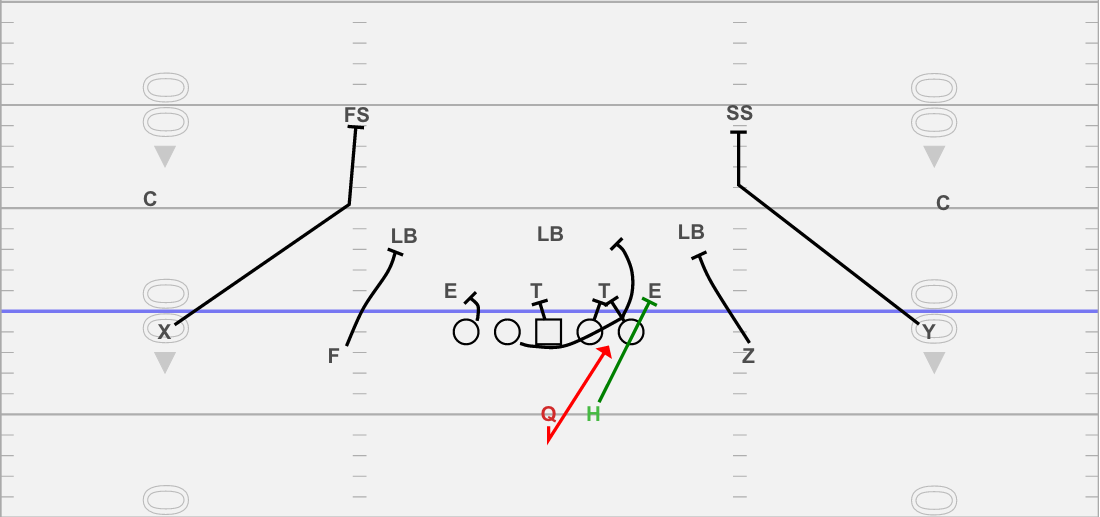
This scheme of gap blocking is based on angles and pulling lineman and backs to create holes in the defense to run through.
Lineman have rules that identify their exact job of either blocking back, double teaming, or pulling.
Each play has a specific spot that should be open after the blocking is executed and running backs have to be disciplined to hit the hole or follow the back or lineman until they break free.
Power schemes all use gap blocking and include a Power, Counter, and even Trapping.
The basic power play is designed to hit in the C Gap or just outside the Tackle.
A running back will kick out the Defensive End and a Guard from the backside will pull and lead up the hole onto a Linebacker.
Everyone else will be blocking down or back a gap depending on the defensive alignment.
Because defenses are set up to defend gaps, each offensive player has a gap to block.
Usually at the point of attack there is a double team block that must get movement to, then they can break off at a backside linebacker.
The counter is based off of similar concepts except it looks like it is going to be a power at the start, and then the kick out and lead blocks are supplied by pulling a guard and tackle from the backside.
The FB fills and everyone else blocks down or back.
The counter will hit outside the tackle to the opposite side of the line.
The toss run in the power scheme includes pulling guards and sometimes tackles and even the Center.
Players who are covered will pull and players who are uncovered will block down or back.
The toss threatens the outside of the defense but the back is looking for the best window to cut upfield and gain yards.
Man Run Scheme
One of the more overlooked schemes to think about as a football run play is a man on man blocking scheme. Basically, this is exactly what it says it is.
One-on-one, mano-e-mano.
Another good way of putting it is to call it the BOB Scheme for Big-On-Big.
But how do they know who they will be blocking?
The simplest way is to have the Center call out his block and then the Guards and Tackles call theirs out.
This way if you work out from the Center’s call and you can count to three, everyone will be blocked.
This is easily the simplest blocking scheme to install and make sure everybody blocks somebody.
But where it gets tricky is when the defense has an extra defender – say 6 to your 5. When this happens, you have to be able to account for the unblocked defender by either running an option, RPO, or blocking him with another player like the running back.
Zone Schemes sometimes use the numbering system to call out blockers, but then still step toward a zone responsibility and call out double teams.
Man schemes don’t care which way they step…they just ID their man and step the best way to block him.
Man schemes also have to know where the running back is going.
If he is going inside, they have to make sure their defender can’t get there, so they might all step inside.
If it’s an outside run, then they would want to try to reach block their man to keep him blocked longer.
Zone Positives and Negatives
One of the major positives to Zone Run’s is that they allow talented RB’s to be creative and use natural vision and athletic ability to find holes in the defense.
If you have every tried to stop a great back with vision in a zone offense, you know what I’m talking about, they can always make you wrong and sometimes the simple plays turn into huge gains.
Zone runs are the #1 most popular play in all of College and NFL football. That shows you just how effective they can be as well as how hard they are to stop.
Zone runs also work very well against anything the defense throws at you. And you can even dress up your zones with loads of option, RPO’s and play-actions.
One scheme to do all that is very attractive!
The negatives are that they favor teams with bigger lineman. Zone’s work on the principle that offensive players get in the way and when you are bigger, you get in the way much more!
While they do take significant time to make effective, the payoff can be huge.
But don’t try it solo if you don’t know everything there is to know about the technique, assignments and adjustments you will need to make to keep it working.
Many zone teams also run Gap runs. But because of the major differences in these two styles, it can get really dicey asking your lineman to be able to flip back and forth between the two at your play-calling whims.
Gap Run Play Positives and Negatives
With Gap Runs, players rarely ever have to block the man in front of them without help. This is a big advantage when you have undersized linemen.
Double Teams are very helpful to take one defenders that you would be outmatched if it were one on one.
There is also a benefit to the design in that gap plays can also bring more players to the point of attack than there are defenders.
From Double Teams, to kick-out or trap blocks, to pull and leads, everything possible is set up to make it very difficult to stop the ball from advancing at a very precise point.
Players know exactly where the ball is going and can be directly coached to execute the play the same way every time.
Against blitzes and stunts, gap run also hold up well because linemen or running backs can take them out with down or back blocks.
The negatives to Gap runs are that it does take time to make sure all the players are executing their assignments in sync and know their individual rules well so anything the defense shows can be blocked.
Good defenses are also taught to read lineman keys like pulling guards to take them to the ball carrier.
Man Positives and Negatives
The positives of a man blocking scheme are that you can easily identify defenders pre-snap and then simply go and block them aggressively.
It also matches up very well with the BOB pass protection that literally could be the exact same technique and assignment.
It would be possible if you throw the ball quickly to avoid downfield blockers that you only need this one single blocking scheme the entire game.
Even if you develop a deep passing game, all you would have to do is teach your players to stay in front of their man instead of aggressively blocking him like a run.
And for play-action, they can fire out like it’s a run, but then hold their ground and stay low making it look very much like a run.
It would be difficult for defenses to also pick up on plays like counters, reverses, passes, and play action because the lineman are all doing the same thing every play.
The negatives are that clearly, a defense can scheme to put their best defender on your worst blocker…and we all know how that’s going to end.
They can also bring heavy blitz pressure which also makes it very difficult to block as defenders will be shooting the gaps between players.
Lastly, any kind of twisting action can get really hairy to stop when players don’t have time to switch.
Summary
Considering what kind of talent you will have every year on your team, you may see one style as better for your program than the other.
But don’t forget that they all have negatives and without a coach or staff that knows how to handle the challenges, any of them can turn into a disaster quickly.
When it comes to linemen, I believe the zone scheme favors a line with size and strength.
The power scheme’s angles allow smaller linemen and backs to block at favorable angles and fire out aggressively with speed.
You can also put your biggest strongest lineman at key positions and he can open up holes for you at the point of attack.
The Man Scheme is a scheme that I would strongly consider using in certain youth football settings where we were just bigger and better or if I had a team that needed to keep things simple to avoid confusion.
From there we could then start teaching it to be more of a zone scheme if the kids were ready.
Next Steps For Learning The Football Run Play
Courses I recommend to help you grow to the next level.

